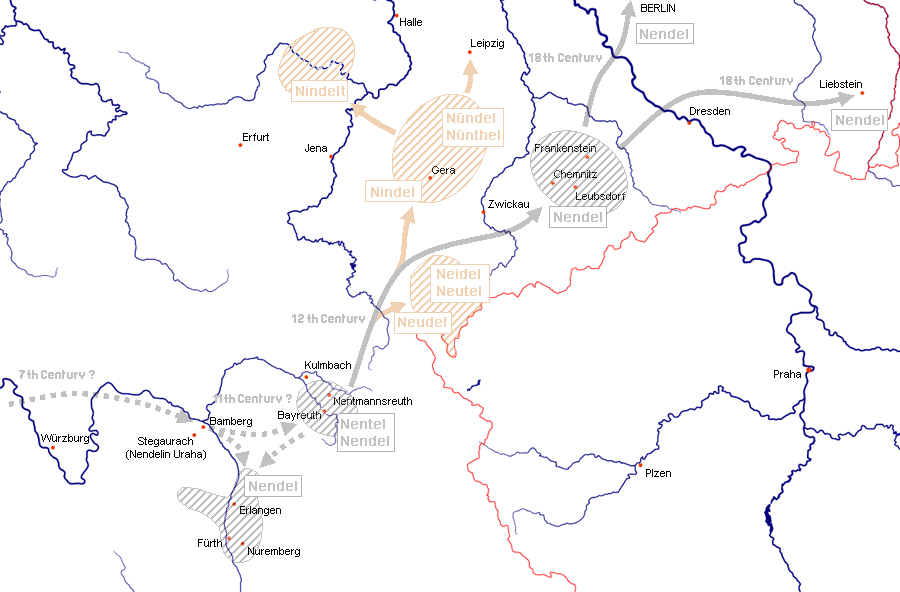The surname Nendel is of germanic origin and can be located in Southern Germany by analysis of village names and other sources. The village Nendingen near Tuttlingen on Danube indirectly proves the existence of a person named Nendo or Nendilo and therfore is the earliest appearance of the name in Germany. These two names are intermediate forms in the development of the surname from the germanic origin to the surname of today. The foundation and name-giving of the village presumably took place under the ingression of the Alemans into the area south of the Danube between 260 and 300 a.c., after the Romans abandoned their Northern borders. The first direct proof of the name is dated between 770 and 781. In the time of Duke Tassilo III, a Nendilo appears as a witness to a donation by the Gaugraf Machelmus concerning the village of Egglfing in the Inn to the Cathedral of St. Stephen in Passau.
Later village foundations with similar names can be found in the North-East of the Franconian Empire on the river Main. They can be dated to between 600 and 800 a.c. for Nendelin Uraha, today Stegaurach near Bamberg, and to between 950 and 1150 for Nenntmannsreuth, north-east of Bayreuth. In this area also the surname Nendel appears in its local form Nentel. In the year 1398 Heinrich Nentel owned a house and a farm in Trebgast near Bayreuth. In 1421 he was still farming the place as tenant of the Margravate Brandenburg. Also Hans Nentel was feoffed with a farm in Mistelbach, southwest of Bayreuth. Mistelbach and Trebgast are located in just a few kilometers distance to Nentmansreuth, where another Nendel family was recorded towards the end of the 16th century. South of Stegaurach, just a bending of the river away from Bayreuth, the surname Nendel is very common. In the latest white pages edition of Germany 45 persons named Nendel are listed in Erlangen, Heßdorf, Hemhofen and the nearest vicinity (Map). That is 39% of all entries in Germany. Such an aggregation is unique. This family group are descendants of the families that lived there in the 16th century. That these Nendels are connected to the founders of Nendelin Uraha and Nenntmannsreuth, is not impossible. In this case the franconian Nendel family group could look back to a history of more than thousand years. But because of insufficient sources of this time it will never be backed up by written evidence. More on this family group can be read in the chapter on the Nendels in Franconia
A second area where the surname Nendel appears unusually often is located north of the Ore Mountains in Saxony (9% of the telephone book entries). In the church books of this region, several hundred entries can be found between the 16th and the 18th century. The oldest families were situated in villages around Leubsdorf (south of Flöha) and around Frankenstein (west of Freiberg). The name Frankenstein points to the fact that the village was founded by Franks. In the 12th century an increasing number of settler trecks moved from Franconia towards the newly declared settlement areas in the eastern border zones. About every tenth Frank tried to change his faith this way. In this period it can be assumed that a man called Nendilo (or maybe he already bore the surname Nendel) left the Franconian settlement area on the upper Main and joined one of the numerous trecks heading east. His treck lead him along the foot of the Ore Mountains into the Flöha valley, where his leader, the locator, gave him a few hectares of recently cleared land. This property was the head cell for the further spreading of the surname Nendel in Saxonia. (Figure 1).
This scenario will presumably never be proven. However, it tells a story that is assumed to have happened with high probability. However, a DNA analysis revealed that the two Nendel families in Saxony and Franconia are not genetically related. This means that the surname Nendel must have developed in two different locations independently.

Figure 1: Distribution of the Nendel/Nentel families in south-east Germany in the 16th century and the assumed migration path
along the northern track of the Frankonian settler movement into the eastern marks in the 12th century.